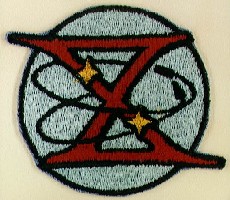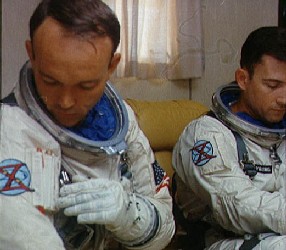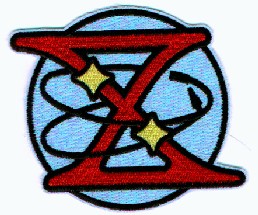

Crew & Mission
The two crews that would made up the Gemini-X mission were selected on January 25, 1966.
Prime crew would be: John W. Young and Michael collins. And back-up crew: James A. Lovell
and Edwin E. Aldrin. After the death of the prime crew for the Gemini-IX mission, the back-up
crew for the Gemini-X mission changed to, Alan Bean and Clifton C. Williams.
On July 18, 1966 the Agena target was launched at 03:39:46 pm EST. This was followed by the Gemini-X launch at 05:20:27 pm. This followd the flight plan exactly and allowed the Gemini-X spacecraft to rendezvous with its target five hours and 21 minutes later. The docking of the two craft was accomplished 31 minutes later, and the two vehicles operated in the docked configuration for 38 hours and 47 minutes.
During the time of docked operations the crew performed six major maneuvers, three of wich used the Agena's primary propulsion system and three wich used the Agena'S secondary propulsion system. The first of the major maneuvers placed the Gemini-X - Agena-X in an elliptical orbit with an apogee of 412.2 miles and a perigee of 158.5 miles.
During the docked period, the Gemini-X crw participated in the first of two major extravehicular activities. This occurred after 23 hours and 24 minutes MET. The hatch of the Gemini-X spacecraft was open for 49 minutes during wich astronaut Collins performed tasks assigned to that phase of the mission. The standing EVA was terminated when both crew members experienced eye irritation.
The crew un-docked from the Agena-X target after 44 hours and 40 minutes MET, and prepared to rendezvous with the Agena-VIII target vehicle which had been in parking orbit since March 16. The second EVA period started 48 hours and 41 minutes MET. This was an umbilical EVA with Collins emerging from the spacecraft and it lasted 39 minutes. During this time Collins retrieved an experiment package which had been attached to the Agena-VIII since march.
The highest apogee reached during the flight was 412.2 miles and the lowest perigee, 86.3 miles. The Gemini-X spacecraft touched down in the Atlantic Ocean at 04:07:06 pm EST July 21, at an estimated 3.4 miles from the planned impact point. The crew chose to be recovered by helicopter and they were landed aboard the USS Guadalcanal 27 minutes after landing. Another 27 minutes passed before the Gemini-X spacecraft was picked up.
The Artwork
The idea for the Gemini-10 patch came from commander John Young but was developed and designed by his wive Barbara, who was a former commercial artist. The patch once again features the twin Gemini stars of Castor and Pollux, this time superimposed on a large aerodynamic Roman nemeral X, wich symbolises the mission designation. The stars represent the two astronauts and the Gemini program.
The design features Gemini-10 and its Agena target vehicle in a chase pattern prior to rendezvous. The orbital paths of the two spacecraft circle the prominent X of the design. In the view of pilot Mike Collins this patch was the best looking of the Gemini series.
Spot the Patch !!!

The crew of Gemini-10 getting ready for their mission.
Souvenir

The souvenier version of the Gemini-10 patch features the names of the crew and also has the corners of the X contained within the circular design. However, the patches the crew wore during the flight had no names on it and had all four coners of the X protruding outside the circular design. The crew wore the patches on the right sleeves of the spacesuits.